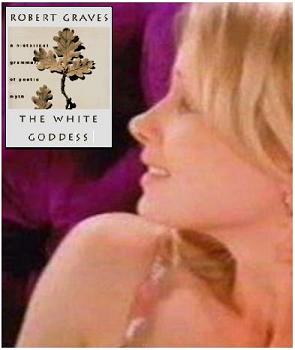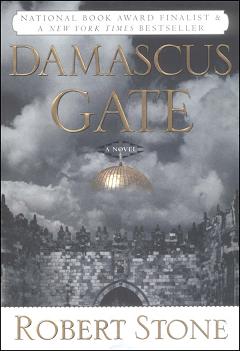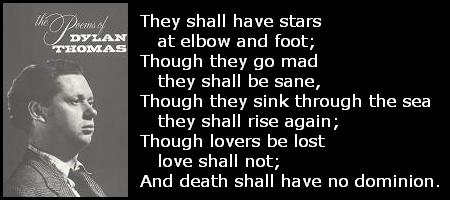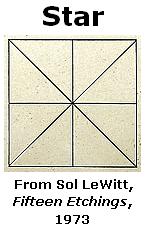From the journal of Steven H. Cullinane...
2005 June 16-30
Thursday, June 30, 2005
2:56 AM
On This Date:
In 1936, Gone with the Wind
was published.
In 1971, Monica Potter
was born.

Sources:
Amazon.com and
Tall Tall Trees
Related material:
There is one story and one story only
That will prove worth your telling,
Whether as learned bard or gifted child;
To it all lines or lesser gauds belong
That startle with their shining
Such common stories as they stray into.
Is it of trees you tell, their months and virtues,
Or strange beasts that beset you,
Of birds that croak at you the Triple will?
Or of the Zodiac and how slow it turns
Below the Boreal Crown,
Prison to all true kings that ever reigned?
Water to water, ark again to ark,
From woman back to woman:
So each new victim treads unfalteringly
The never altered circuit of his fate,
Bringing twelve peers as witness
Both to his starry rise and starry fall.
Or is it of the Virgin's silver beauty,
All fish below the thighs?
She in her left hand bears a leafy quince;
When, with her right hand she crooks a finger, smiling,
How may the King hold back?
Royally then he barters life for love.
Or of the undying snake from chaos hatched,
Whose coils contain the ocean,
Into whose chops with naked sword he springs,
Then in black water, tangled by the reeds,
Battles three days and nights,
To be spewed up beside her scalloped shore?
Much snow is falling, winds roar hollowly,
The owl hoots from the elder,
Fear in your heart cries to the loving-cup:
Sorrow to sorrow as the sparks fly upward.
The log groans and confesses:
There is one story and one story only.
Dwell on her graciousness,
dwell on her smiling,
Do not forget what flowers
The great boar trampled down in ivy time.
Her brow was creamy as the crested wave,
Her sea-blue eyes were wild
But nothing promised that is not performed.
-- Robert Graves,
To Juan at the Winter Solstice
Wednesday, June 29, 2005
7:00 PM
Meditation for St. Peter's Day
"Religious
activists fool themselves if they believe public displays of the Ten
Commandments reflect a more moral and less corrupt nation. One needs
only to watch television to discern the level of our depravity."
-- Cal Thomas, June 28, 2005
For further details, see
Wednesday, June 29, 2005
12:00 PM
Reading for St. Peter's Day:

Click on picture for details.
Wednesday, June 29, 2005
10:45 AM
Monday, June 27, 2005
1:09 PM
Monday, June 27, 2005
3:26 AM
For of Such is the
Kingdom of Heaven
From today's online New York Times,
with a slight embellishment:

Monday, June 27, 2005
12:00 AM
Into the Dark
O dark dark dark. They all go into the dark,
The vacant interstellar spaces, the vacant into the vacant
....
And we all go with them, into the silent funeral,
Nobody's funeral, for there is no one to bury.
I said to my soul, be still, and let the dark come upon you
Which shall be the darkness of God. As, in a theatre,
The lights are extinguished, for the scene to be changed
With a hollow rumble of wings, with a movement of
darkness on darkness....
-- T. S. Eliot, Four Quartets
"I’m
well past eighty now and fairly certain I won’t see ninety but I’d like
more of a choice than Hell or Paradise when I leave. Now that we know
the Bible was created by a vote of Emperor Constantine’s clergy,
wouldn’t we all be better off if other options were offered? Or is the
fear of what happens after death the glue that holds Religion together?
I hope not because I believe better of God.
As a Deist I, have
no fear or doubts of the way that life ends. I can bravely face the
reality of ceasing to exist because the God of my heart comforts me by
promising to provide a dark, starless night of nothingness when my
visit is over."
-- Paul Winchell (pdf) (See previous entry.)
Paul Winchell was born at the winter solstice -- the longest night -- December 21, 1922.
For another view of the longest night, see the five Log24 entries ending on the day after the longest night of 2003. Summary of those entries:
After the Long Night

Sunday, June 26, 2005
7:26 PM
Thanks for the Memory
As I write, Susannah McCorkle is singing "Thanks for the Memory."
Below are some photos from the website of Paul Winchell, ventriloquist, inventor, theologian. Winchell died in his sleep at 82 early on Friday, June 24, 2005.
"God is a mathematical equation
beyond our understanding."
Related material:
From Friday's entry --
Cross by Sol LeWitt
(Fifteen Etchings, 1973):

"No bridge reaches God, except one...
God's Bridge: The Cross."
-- Billy Graham Evangelistic Association,
quoted in Friday's entry.
This cross may, of course, also
be interpreted as panes of a window
-- see Lucy photo above --
or as a plus sign -- see "a mathematical
equation beyond our understanding"
in, for instance, Algebraic Geometry,
by Robin Hartshorne. For a theological
citation of Hartshorne's work, see
Midsummer Eve's Dream
(June 23, 1995).
Saturday, June 25, 2005
12:00 AM
Religious Symbolism
at Midnight:

Related material:
Star Wars 6/13/05,
Dark City 6/14/05,
and De Arco, as well
as the following from
July 26, 2003:
| Bright Star and Dark Lady "Mexico
is a solar country -- but it is also a black country, a dark country.
This duality of Mexico has preoccupied me since I was a child." -- Octavio Paz,
quoted by Homero Aridjis |
| 
Bright Star 
| 
Amen. | 
Dark Lady 
|
Friday, June 24, 2005
4:07 PM
Geometry for Jews
continued:

People have tried in many ways
to bridge the gap
between themselves and God....
No bridge reaches God, except one...
God's Bridge: The Cross
-- Billy Graham Evangelistic Association,
according to messiahpage.com
"... just as God defeats the devil:
this bridge exists;
it is the theory of the field
of algebraic functions over
a finite field of constants
(that is to say, a finite number
of elements: also said to be a Galois
field, or earlier 'Galois imaginaries'
because Galois first defined them
and studied them....)"
-- André Weil, 1940 letter to his sister,
Simone Weil, alias Simone Galois
(see previous entry)
Related material:
Billy Graham and the City:
A Later Look at His Words
-- New York Times, June 24, 2005
Geometry for Jews
and other art notes
Thursday, June 23, 2005
3:00 PM
Mathematics and Metaphor
The current (June/July) issue of the Notices of the American Mathematical Society has two feature articles. The first, on the vulgarizer Martin Gardner, was dealt with here in a June 19 entry, Darkness Visible. The second is related to a letter of André Weil (pdf) that is in turn related to mathematician Barry Mazur's attempt to rewrite mathematical history and to vulgarize other people's research by using metaphors drawn, it would seem, from the Weil letter.
A Mathematical Lie
conjectures that Mazur's revising of history was motivated by a desire
to dramatize some arcane mathematics, the Taniyama conjecture, that
deals with elliptic curves and modular forms, two areas of mathematics
that have been known since the nineteenth century to be closely
related.
Mazur led author Simon Singh to believe that these
two areas of mathematics were, before Taniyama's conjecture of 1955,
completely unrelated --
"Modular forms and elliptic
equations live in completely different regions of the mathematical
cosmos, and nobody would ever have believed that there was the remotest
link between the two subjects." -- Simon Singh, Fermat's Enigma, 1998 paperback, p. 182
This is false. See Robert P. Langlands, review of Elliptic Curves, by Anthony W. Knapp, Bulletin of the American Mathematical Society, January 1994.
It now appears that Mazur's claim was in part motivated by a desire to
emulate the great mathematician André Weil's manner of speaking; Mazur
parrots Weil's "bridge" and "Rosetta stone" metaphors --
From Peter Woit's weblog, Feb. 10, 2005:
"The focus of Weil's letter is the analogy between number fields and
the field of algebraic functions of a complex variable. He describes
his ideas about studying this analogy using a third, intermediate
subject, that of function fields over a finite field, which he thinks
of as a 'bridge' or 'Rosetta stone.'"
In "A 1940 Letter of André Weil on Analogy in Mathematics," (pdf), translated by Martin H. Krieger, Notices of the A.M.S., March 2005, Weil writes that
"The purely algebraic theory of algebraic functions in any arbitrary
field of constants is not rich enough so that one might draw useful
lessons from it. The 'classical' theory (that is, Riemannian) of
algebraic functions over the field of constants of the complex numbers
is infinitely richer; but on the one hand it is too much so, and in the
mass of facts some real analogies become lost; and above all, it is too
far from the theory of numbers. One would be totally obstructed if
there were not a bridge between the two. And just as God defeats the devil: this bridge exists; it is the theory of the field of algebraic functions over a finite field of constants....
On the other hand, between the function fields and the 'Riemannian'
fields, the distance is not so large that a patient study would not
teach us the art of passing from one to the other, and to profit in the
study of the first from knowledge acquired about the second, and of the
extremely powerful means offered to us, in the study of the latter,
from the integral calculus and the theory of analytic functions. That
is not to say that at best all will be easy; but one ends up by
learning to see something there, although it is still somewhat
confused. Intuition makes much of it; I mean by this the faculty of
seeing a connection between things that in appearance are completely
different; it does not fail to lead us astray quite often. Be that as
it may, my work consists in deciphering a trilingual text {[cf. the Rosetta Stone]};
of each of the three columns I have only disparate fragments; I have
some ideas about each of the three languages: but I know as well there
are great differences in meaning from one column to another, for which
nothing has prepared me in advance. In the several years I have worked
at it, I have found little pieces of the dictionary. Sometimes I worked
on one column, sometimes under another."
Here is another statement of the Rosetta-stone metaphor, from Weil's translator, Martin H. Krieger, in the A.M.S. Notices of November 2004, "Some of What Mathematicians Do" (pdf):
"Weil refers to three columns, in analogy with the Rosetta Stone’s
three languages and their arrangement, and the task is to 'learn to
read Riemannian.' Given an ability to read one column, can you find
its translation in the other columns? In the first column are
Riemann’s transcendental results and, more generally, work in analysis
and geometry. In the second column is algebra, say polynomials with
coefficients in the complex numbers or in a finite field. And in the
third column is arithmetic or number theory and combinatorial
properties."
For greater clarity, see Armand Borel (pdf) on Weil's Rosetta stone,
where the three columns are referred to as Riemannian (transcendental),
Italian ("algebraico-geometric," over finite fields), and arithmetic
(i.e., number-theoretic).
From Fermat's Enigma, by Simon Singh, Anchor paperback, Sept. 1998, pp. 190-191:
Barry
Mazur: "On the one hand you have the elliptic world, and on the other
you have the modular world. Both these branches of mathematics had
been studied intensively but separately.... Than along comes the
Taniyama-Shimura conjecture, which is the grand surmise that there's a bridge between these two completely different worlds. Mathematicians love to build bridges."
Simon Singh: "The value of mathematical bridges
is enormous. They enable communities of mathematicians who have been
living on separate islands to exchange ideas and explore each other's
creations.... The great potential of the Taniyama-Shimura conjecture
was that it would connect two islands and allow them to speak to each
other for the first time. Barry Mazur thinks of the Taniyama-Shimura
conjecture as a translating device similar to the Rosetta stone.... 'It's as if you know one language and this Rosetta stone
is going to give you an intense understanding of the other language,'
says Mazur. 'But the Taniyama-Shimura conjecture is a Rosetta stone with a certain magical power.'"
If Mazur, who is scheduled to speak at a conference on Mathematics and Narrative this July, wants more material on stones with magical powers, he might consult The Blue Matrix and The Diamond Archetype.
Tuesday, June 21, 2005
4:24 PM
Art History
"I studied with Reinhardt and I found that a fantastic course. I think he was really very stimulating....
Art history was very personal through the eyes of Ad Reinhardt."
-- Robert Morris,
Smithsonian Archives of American Art
Related material:
"The Road to Simplicity Followed by Merton’s Friends: Ad Reinhardt and Robert Lax" in The Merton Annual 13 (2000) 245-256, by Paul J. Spaeth, library director at St. Bonaventure University
The Merton here is Trappist monk Thomas Merton. Here is Merton in a letter to poet Robert Lax on the death of their friend Ad Reinhardt, sometimes called the "black monk" of abstract art:
"Make
Mass beautiful silence like big black picture speaking requiem. Tears
in the shadows of hermit hatch requiems blue black tone. Sorrows for Ad
in the oblation quiet peace request rest. Tomorrow is solemns in the
hermit hatch for old lutheran reinhardt commie paintblack… Tomorrow is
the eternal solemns and the barefoots and the ashes and the masses,
oldstyle liturgy masses without the colonels… Just old black quiet
requiems in hermit hatch with decent sorrows good by college chum."
-- from J. S. Porter, "Farewell to a Monk,"
Antigonish Review, Winter 1997
Sunday, June 19, 2005
4:00 AM
ART WARS:
Darkness Visible
"Ed Rinehart [sic]
made a fortune painting canvases that were just one solid color. He
had his black period in which the canvas was totally black. And then
he had a blue period in which he was painting the canvas blue. He was
exhibited in top shows in New York, and his pictures wound up in
museums. I did a column in Scientific American on minimal art,
and I reproduced one of Ed Rinehart's black paintings. Of course, it
was just a solid square of pure black. The publisher insisted on
getting permission from the gallery to reproduce it."
Fade to Black
"...that
ineffable constellation of talents that makes the player of rank: a
gift for conceiving abstract schematic possibilities; a sense of
mathematical poetry in the light of which the infinite chaos of
probability and permutation is crystallized under the pressure of
intense concentration into geometric blossoms; the ruthless focus of
force on the subtlest weakness of an opponent." -- Trevanian, Shibumi "'Haven't there been splendidly elegant colors in Japan since ancient times?' 'Even black has various subtle shades,' Sosuke nodded." -- Yasunari Kawabata, The Old Capital
An Ad Reinhardt painting
described in the entry of
noon, November 9, 2004
is illustrated below.

Ad Reinhardt,
Abstract Painting, 1960-66.
Oil on canvas, 60 x 60 inches.
Solomon R. Guggenheim Museum
The viewer may need to tilt
the screen to see that this
painting is not uniformly black,
but is instead a picture of a
Greek cross, as described below.
"The
grid is a staircase to the Universal.... We could think about Ad
Reinhardt, who, despite his repeated insistence that 'Art is art,'
ended up by painting a series of... nine-square grids in which the
motif that inescapably emerges is a Greek cross. Greek Cross
There
is no painter in the West who can be unaware of the symbolic power of
the cruciform shape and the Pandora's box of spiritual reference that
is opened once one uses it." -- Rosalind Krauss,
Meyer Schapiro Professor
of Modern Art and Theory
at Columbia University
(Ph.D., Harvard U., 1969),
in "Grids"

Krauss |
In memory of
St. William Golding
(Sept. 19, 1911 - June 19, 1993)
Friday, June 17, 2005
4:01 PM
Lorna Thayer, 85,
the waitress in Five Easy Pieces,
who was once someone's little princess,
died on June 4, 2005.

Lorna Thayer,
1954
The 2 PM June 4 Log24 entry
has a link to
The Quality of Diamond,
where more of the Lorna Thayer
story may be found.
Thursday, June 16, 2005
2:02 PM
"Joe Strauss to
Joe Six-Pack"
(Editor's sneering headline
for a David Brooks essay
in today's New York Times)
and Back Again
"I was emptying some boxes in my basement the other day and I came
across an essay somebody had clipped on Ernest Hemingway from the July
14, 1961, issue of Time magazine. The essay was outstanding. Over three
pages of tightly packed prose, with just a few photos, the anonymous
author performed the sort of high-toned but accessible literary
analysis that would be much harder to find in a mass market magazine
today....
The sad thing is that this type of essay was not unusual in that era....
The magazines would devote pages to the work of theologians like
Abraham Joshua Heschel* or Reinhold Niebuhr. They devoted as much space
to opera as to movies because an educated person was expected to know
something about opera, even if that person had no prospect of actually
seeing one....
Back in the late 1950's and early 1960's,
middlebrow culture, which is really high-toned popular culture, was
thriving in America. There was still a sense that culture is good for
your character, and that a respectable person should spend time
absorbing the best that has been thought and said."
-- David Brooks,
The New York Times,
June 16, 2005
The Time essay begins by quoting Hemingway himself:
"All stories,
if continued far enough,
end in death,
and he is no true storyteller
who would keep that from you."
Here is the top section of today's
New York Times obituaries.
-- and here is a link that returns,
as promised in this entry's headline,
to "Joe Strauss" --
complete with polkas.
* "Judaism is a religion of time, not space."
-- Wikipedia on Heschel.
See the recent Log24 entries
Star Wars continued,
Dark City, and
Cross-Referenced, and last year's
Bloomsday at 100.



























